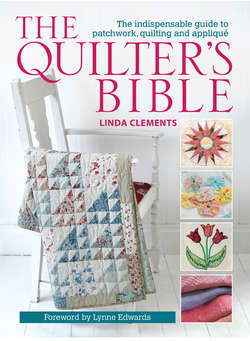Читать книгу The Quilter's Bible - Linda - Страница 32
На сайте Литреса книга снята с продажи.
Estimating Fabric Requirements
ОглавлениеIf you are creating designs of your own or making a sampler quilt from different blocks you will need to be able to estimate fabric amounts – there’s nothing worse than running out of a crucial fabric before a project is completed. If you are making a project from a book or magazine, the fabric requirements are usually provided, although some lists may be very general. Making a sketch of the overall quilt design and the block designs (see diagrams A and B) is a good starting point as you can then list the separate elements that will need fabric, including those needed for blocks, sashing, borders, backing and edging. Estimates need to be generous to allow for seams, fabric grain and mistakes.
Overall quilt size – The finished size of a quilt depends on the bed it needs to fit and whether you wish it to just drape over the top or reach the floor on all sides. There are tables of standard bed sizes (see Useful Information) and wadding (batting) is also sold in these standard sizes. For a customized fit, measure the bed the quilt is needed for.
Blocks – Make a sketch of the block you want to make, labelling each part that will use a different fabric (B). Make a list of the total number of pieces needed in each colour for the block and multiply this by the total number of those blocks in the quilt. Make another sketch to estimate how many pieces can be cut from a yard, half yard or fat quarter. Do this for each different block.
Sashing and borders – These are normally cut on the straight grain and are usually rectangles, so draw a sketch of the pieces needed in each colour (diagram C above). Decide what size each piece will be and sketch the pieces side by side to see how many will fit across the fabric. Remember the selvedge, subtracting about 2in (5cm) from the width.
Backing – Backing fabric normally needs to be about 6in (15.2cm) wider than the quilt top. Whether it is seamed or not depends on the overall size of your quilt and the width of backing you are using. Seams can be horizontal or vertical. Fabric is normally 42in (106.7cm) but extra wide backing fabric is available, which means fewer seams. See Choosing Backing Fabric for more on backing.
Binding – Fabric needed for binding depends on the width of the binding and whether it is to be single or double, cut on the straight grain or on the bias – see Binding as an Edging for more on binding. There are tables of binding fabric requirements and an example is given here. Double-fold binding cut on the straight grain 21⁄2in (6.3cm) wide sufficient for a double (full) bed = 270in (686cm) approximately and would require 1⁄2yd (0.5m) of fabric or 2⁄3yd (0.75m) if cut on the bias.
Appliqué motifs – The easiest way to calculate how much fabric you need for appliqué work is to draw the motif within an easy geometric shape, such as a square and then measure the geometric shape – see Calculating Fabric for Appliqué for more details.
